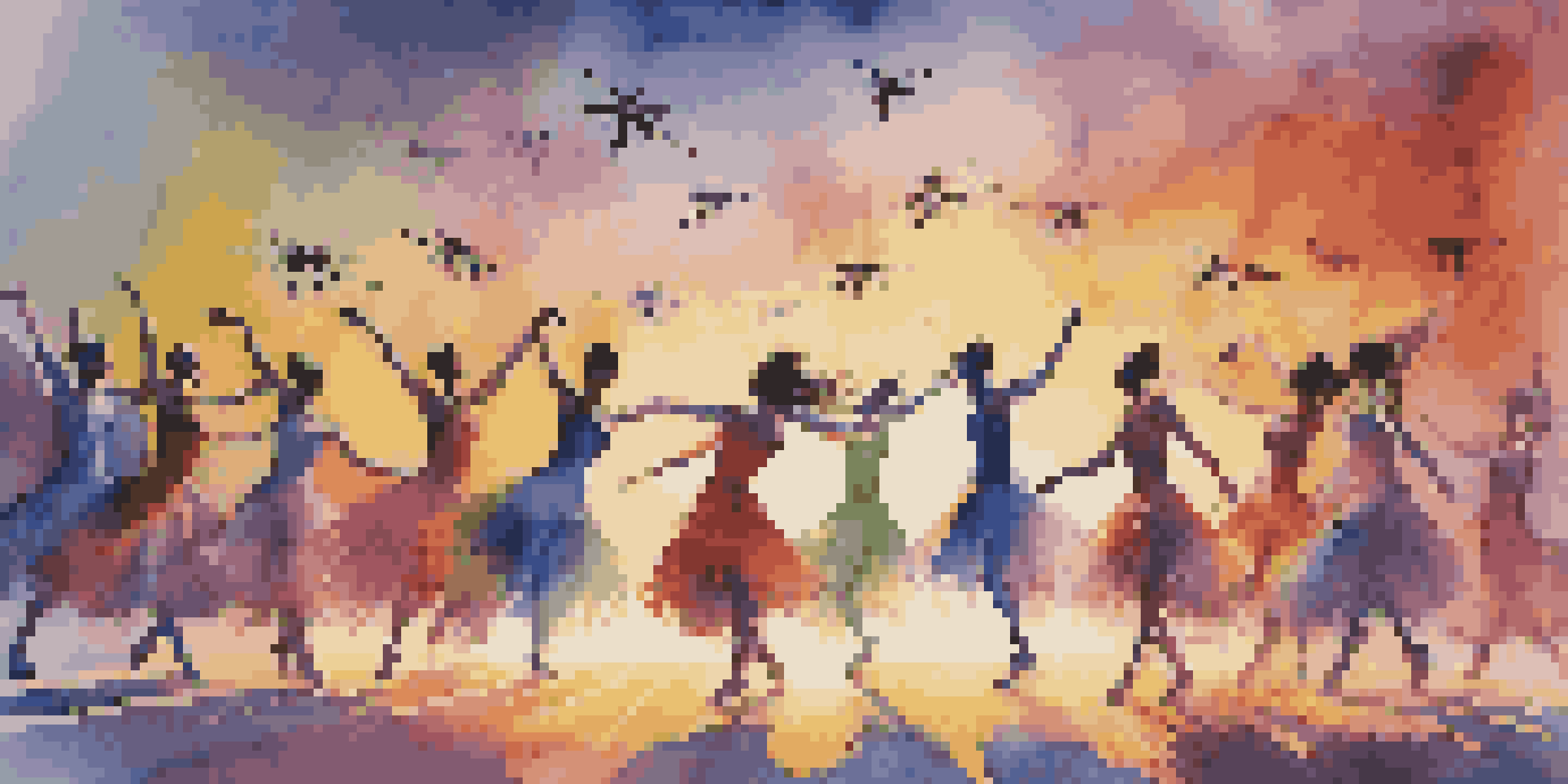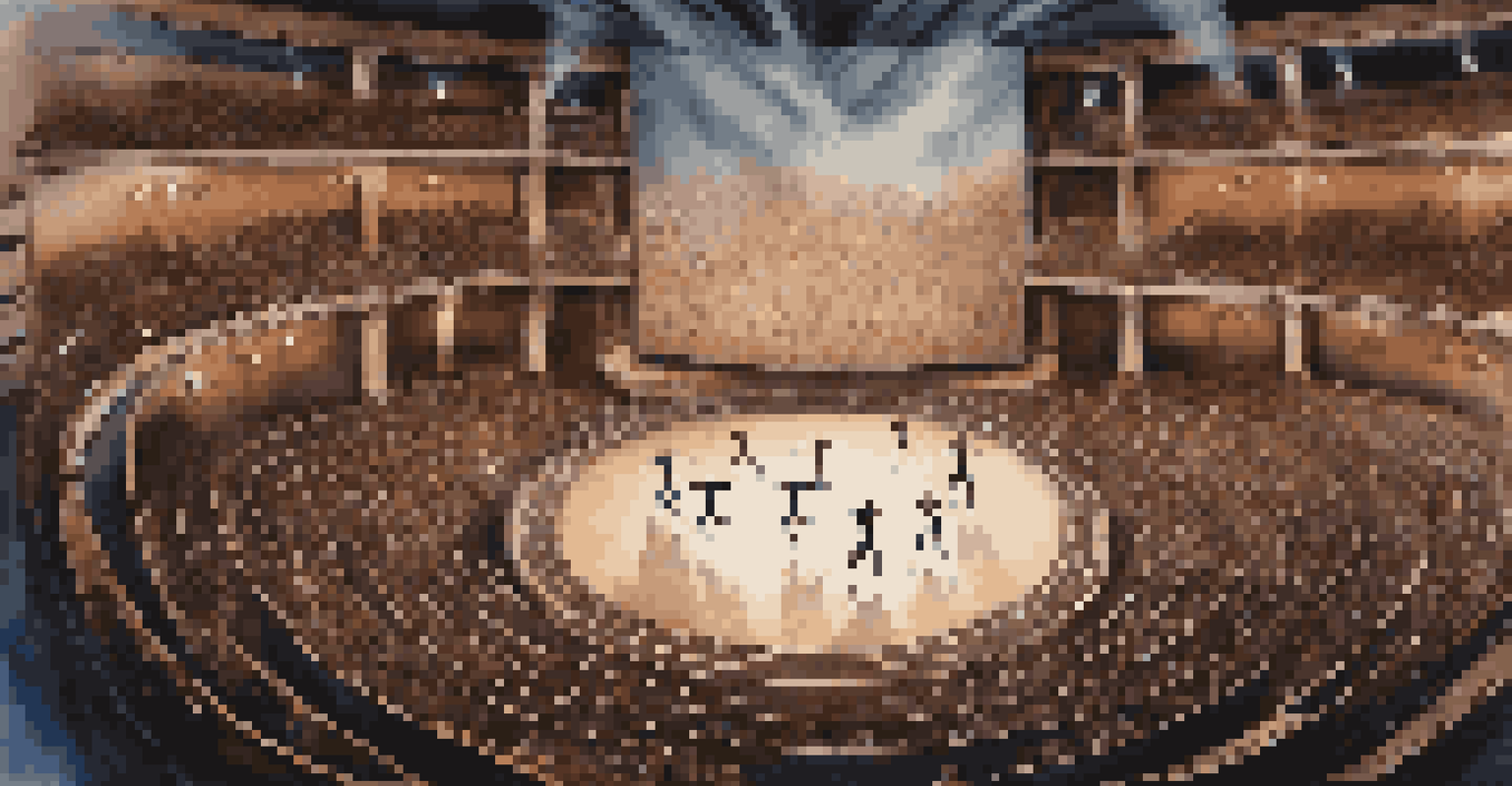Using Drones in Dance: A New Perspective on Performance

The Intersection of Technology and Dance
As technology continues to evolve, the arts are finding innovative ways to integrate it into their practices. Dance, a form of expression deeply rooted in movement, is now seeing an exciting intersection with drone technology. This fusion not only enhances the visual experience but also broadens the horizon of what dance performances can entail.
Technology is best when it brings people together.
Imagine a stage where dancers are not just performing on the ground, but are accompanied by flying drones capturing their movements from above. This creates a dynamic interplay, adding a layer of storytelling that traditional performances may lack. The aerial perspective can transform the audience’s experience, highlighting choreography in ways that were previously unimaginable.
Furthermore, as choreographers embrace drone technology, they can choreograph with the camera in mind. This presents unique opportunities to create engaging visuals that resonate with audiences, making the performance not just a display of dance, but a multi-dimensional experience.
Enhancing Stage Design with Drones
Drones are not just for aerial photography; they are becoming pivotal in stage design for dance performances. By incorporating drones into the staging, artists can create stunning visual effects that complement the rhythm and flow of the dance. Drones can be programmed to move in sync with dancers, creating a harmonious blend between technology and art.

Consider how lighting plays a significant role in dance; now imagine drones equipped with lights that can change colors and patterns mid-performance. This brings a new level of interactivity, allowing for an evolving backdrop that responds to the dancers’ movements. It’s a fascinating way to keep the audience engaged and intrigued.
Drones Enhance Dance Performances
The integration of drones into dance creates dynamic visual narratives, transforming traditional performances into multi-dimensional experiences.
Moreover, the use of drones can help set the mood for different scenes within a performance. Whether it’s a soft, ethereal glow or a dramatic spotlight, drones offer flexibility that traditional lighting methods may not provide, enhancing the overall ambiance of the dance.
Drones as Dance Partners
The concept of drones as dance partners may sound futuristic, but it’s becoming a reality. Dancers can interact with drones in real-time, creating a partnership that blurs the lines between human and machine. This interaction adds complexity to choreography, inviting dancers to explore new movements that respond to the drones’ actions.
Art is the most beautiful of all lies; it illuminates our deepest truths.
For instance, a dancer might initiate a movement that triggers a drone to follow or mirror them, creating a captivating dialogue between the two. This relationship challenges traditional notions of performance and collaboration, pushing artists to think outside the box. Drones are not just observers; they become an integral part of the dance narrative.
This innovative partnership can also inspire improvisation, where dancers adapt their movements based on the drone's behavior. Such spontaneity can lead to unique performances, as each show becomes a distinct experience for both the performers and the audience.
Choreographing for Drones: A New Approach
Choreographing a dance that incorporates drones requires a fresh perspective and innovative thinking. Unlike traditional choreography, where the focus is solely on the dancers, choreographers must consider the drones' movements, flight paths, and timing. This adds a layer of complexity that can lead to exciting new creative possibilities.
Dancers need to be aware of their spatial relationships with the drones, ensuring that their movements complement rather than clash with the aerial performers. This collaboration can lead to unique formations and patterns that would be impossible without drones, enhancing the overall choreography.
Interactive Choreography with Drones
Dancers can interact with drones in real-time, fostering a unique partnership that challenges conventional choreography and encourages improvisation.
Additionally, choreographers can experiment with various drone capabilities, such as altitude changes and speed variations, to create a more dynamic performance. This not only enriches the dance but also challenges dancers to adapt and evolve their techniques, pushing the boundaries of their art.
Audience Engagement Through Aerial Perspectives
One of the most exciting aspects of integrating drones into dance is the potential for increased audience engagement. By providing aerial perspectives, drones allow viewers to experience the performance from angles they wouldn't typically see. This can create a more immersive experience, drawing the audience deeper into the narrative.
Imagine watching a dance from above, where the movements create intricate patterns that are only visible from the sky. This unique viewpoint can evoke a sense of wonder and curiosity, encouraging audiences to appreciate the art form from a different angle. It also invites them to consider the relationship between the dancers and the technology that accompanies them.
Moreover, drone footage can be shared on social media, extending the reach of the performance beyond the theater. Audiences can relive the experience, share it with others, and engage in discussions about the unique blend of technology and art.
Safety and Regulations in Drone Usage
While the use of drones in dance offers exciting possibilities, it also comes with its own set of challenges, particularly regarding safety and regulations. Ensuring the safety of performers and audience members is paramount, which means adhering to strict guidelines set by aviation authorities. This includes understanding flight paths, altitude restrictions, and no-fly zones.
Dancers and drone operators must undergo training to ensure seamless integration during performances. This training helps prevent accidents and guarantees that both the dancers and drones can perform at their best. Safety protocols are crucial to preventing mishaps that could disrupt the performance.
Safety and Regulations Are Crucial
Ensuring safety and adherence to regulations is essential for the successful integration of drones in dance, protecting both performers and audiences.
Additionally, as the popularity of using drones in the arts grows, regulations are likely to evolve. Artists and organizations must stay informed about the latest laws to ensure compliance and foster a safe environment for creative exploration.
The Future of Drones in Dance Performances
Looking ahead, the future of drones in dance performances is brimming with potential. As technology continues to advance, we can expect to see even more innovative uses of drones in the arts. From enhanced choreography to groundbreaking visual effects, the possibilities seem endless.
Collaborations between choreographers, dancers, and drone operators are likely to become more commonplace, leading to new art forms that blend movement and technology. This could inspire a new generation of artists to explore the intersection of dance and technology, creating fresh and exciting performances.

Ultimately, the integration of drones in dance is not just about the technology itself; it’s about the stories and emotions that can be conveyed through this unique collaboration. As artists continue to push boundaries, we may witness performances that redefine our understanding of dance and its possibilities.